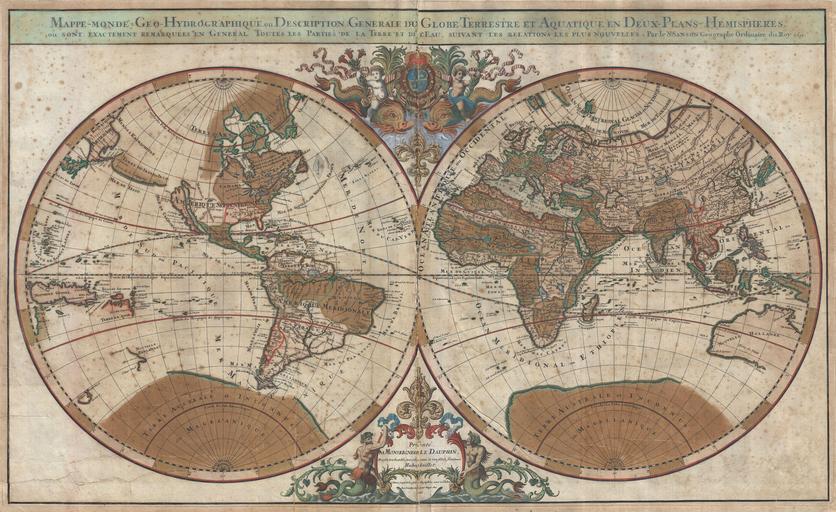MAKE A MEME
View Large Image

| View Original: | 1691_Sanson_Map_of_the_World_on_Hemisphere_Projection_-_Geographicus_-_World-sanson-1691.jpg (6000x3675) | |||
| Download: | Original | Medium | Small | Thumb |
| Courtesy of: | commons.wikimedia.org | More Like This | ||
| Keywords: 1691 Sanson Map of the World on Hemisphere Projection - Geographicus - World-sanson-1691.jpg An extraordinary map of monumental proportions this Sanson and Jaillot's 1691 decorative map of the world on a double hemisphere projection This is the first state of the fourth plate of this map Covers the entire world according to its 17th century conception Elaborate allegorical cartouches appear at top center and bottom center detailing cherubs riding dolphins - the symbols of the Dauphin of France This map is magnificently colored with extensive gold foiling used throughout both as accent elements and to denote cities This type of elaborate colorization theme is highly unusual as gold foil gilting and color work of this caliber was generally only applied to maps that were commissioned for royalty or the high nobility The is the only example of this map with such colorization we have ever seen Our survey of this map will begin in North America where California is depicted as an island The idea of an insular California first appeared as a work of fiction in Garci Rodriguez de Montalvo's c 1510 romance Las Sergas de Esplandian where he writes Know that on the right hand of the Indies there is an island called California very close to the side of the Terrestrial Paradise; and it is peopled by black women without any man among them for they live in the manner of Amazons Baja California was subsequently discovered in 1533 by Fortun Ximenez who had been sent to the area by Hernan Cortes When Cortez himself traveled to Baja he must have had Montalvo's novel in mind for he immediately claimed the Island of California for the King By the late 16th and early 17th century ample evidence had been amassed by explorations of the region by Francisco de Ulloa Hernando de Alarcon and others that California was in fact a Peninsula and not and island However by this time other factors were in play Francis Drake had sailed north and claimed New Albion near modern day Washington or Vancouver for England The Spanish thus needed to promote Cortes' claim on the Island of California to preempt English claims on the western coast of North America The significant influence of the Spanish crown on European cartographers caused a major resurgence of the Insular California theory of which Sanson was a primary proponent in the mid to late 17th century Shortly after this map was made Eusebio Kino a Jesuit missionary traveled overland from Mexico to California proving conclusively the peninsularity of California Traveling northwest away from the mainland we come across a land labeled Terre de Jesso or Je Co or Terre de la Compagnie Though Yesso or Jesso is a name usually associated with Hokkaido which here is drawn as part of mainland Asia this land mass is more commonly called Gama or Gamaland Gama was supposedly discovered in the 17th century by a mysterious figure known as Jean de Gama Various subsequent navigators claim to have seen this land and it appeared in numerous maps well into the late 18th century At times it was associated with Hokkaido in Japan and at other times with the mainland of North America On this map we are struck by its uncanny resemblance to Gerhard Muller's peninsula which emerged in the late 18th century Based on numerous sightings but no significant exploration of the Aleutian Islands Muller postulated that the archipelago was in fact a single land mass This he mapped extending from the North American mainland towards Asia much as the Terre de Compagnie does on this map It is not inconceivable that navigators sailing in the northern seas from Asia could have made this same error in the 16th and 17th centuries Moving east of California into the North American mainland we find ourselves in the Spanish colony of New Mexico 1691 dated Size in 35 5 22 object history credit line accession number World-sanson-1691 Jaillot H <i>Atlas Nouveau</i> 1691 edition Geographicus-source PD-Art-100 Maps by Nicolas Sanson world 1691 maps world Old maps of Earth's hemispheres Maps in French world | ||||